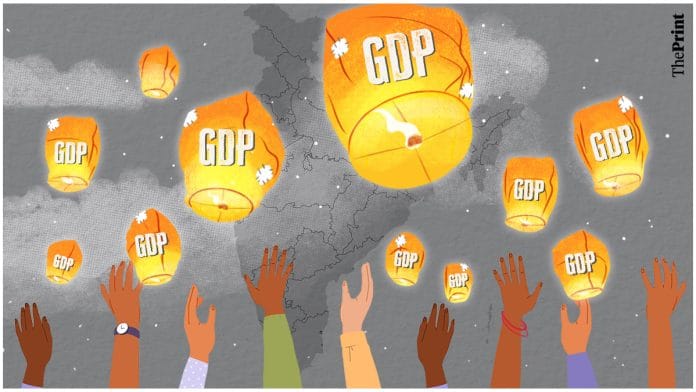In her 2024 Union Budget speech, Finance Minister Nirmala Sitharaman said, “From 2026-27 onwards, our endeavour will be to keep the fiscal deficit each year such that the Central Government debt will be on a declining path as a percentage of GDP.” The Finance Secretary TV Somanathan reiterated the same in an interview with ThePrint. However, the debt/GDP ratio is not a reliable basis for fiscal policy owing to problems in GDP measurement.
The government may also end up committing to a pro-cyclical fiscal policy—running larger deficits when times are good, and having limited fiscal space during bad times. This limits the government’s ability to deal with crises, and can have adverse effects on economic outcomes.
The measurement challenge
In India, measuring the debt/GDP ratio is fraught with challenges because GDP measurement is unreliable. If we can’t measure GDP accurately, we are shooting in the dark with our fiscal deficit targets potentially leading to misguided policy decisions. Additionally, any medium to long-term fiscal strategy will involve making projections on the debt/GDP ratio. These are extremely vulnerable to interest rate and GDP growth rate assumptions. If the government can borrow at a lower rate, then it has more room for adding to its debt. For this to work, the government will have to consider a variety of interest rate scenarios, and outline its fiscal strategy accordingly. There is also an incentive to keep interest rates low to ensure smoother fiscal management.
Interest payments as a percentage of revenue receipts come from well-defined transactions. If 40 per cent of government revenue is used for interest payments, it gives us a clearer picture of the remaining fiscal space for other expenditures. Revenue receipts also provide a more accurate picture of the government’s “income” compared to the GDP, as they directly reflect the actual funds available for spending, unlike GDP, which encompasses the total economic output but doesn’t directly translate into government revenue.
Also read: Indian economy has rung 3 alarm bells. The new govt must deal with it within 100 days
How will the glide path play out?
Let’s consider a straightforward example: For the past decade, the government has earned Rs 100 in revenue and spent Rs 140 each year, resulting in an annual fiscal deficit of Rs 40. With a constant GDP of Rs 1,000, the fiscal deficit is 4 per cent of GDP. The government borrows Rs 40 each year to cover its expenditures, accumulating a total debt of Rs 400. Consequently, the debt/GDP ratio has risen to 40%. Historically, the government has aimed to keep the fiscal deficit as a percentage of GDP below a certain threshold. The latest budget speech indicates that starting from FY27, the government intends to adjust the fiscal deficit to reduce the debt/GDP ratio.
Now, let’s explore how this glide path would function in different economic scenarios:
In a good year: During economic booms when GDP rises, the debt/GDP ratio should ideally decline. The government can afford to run a larger fiscal deficit without significantly increasing the debt/GDP ratio, which is considered pro-cyclical.
In a bad year: When the economy is struggling, GDP falls, and the debt/GDP ratio tends to rise. In such conditions, the government must maintain a very small fiscal deficit to prevent further increases in the debt/GDP ratio. This is also pro-cyclical.
Targeting the deficit based on the debt/GDP ratio risks encouraging larger deficits during good times. This limits the ability of governments to respond to a crisis and undertake large-scale welfare spending in bad times.
The fiscal policy challenge
In challenging circumstances such as wars, global crises, or pandemics, it is almost impossible for governments to not respond. Take the recent example of Covid-19. The government needed to increase its welfare spending to relieve some of the stress that households and firms were facing. In the Organisation for Economic Co-operation and Development (OECD) countries, large amounts of spending were incurred to soften the blow of reduced economic activity. Our fiscal depth was lower, and hence we could not undertake the scale of expenditures that the OECD countries did.
Governments have two strategies in such times—they can either run down their primary surplus or borrow from financial markets. Both options are feasible if fiscal policy has been conservative in good times. A primary surplus allows the government the room to take on deficits. A good fiscal track record makes the market comfortable in lending to the government. Many will claim that the latter is not a problem in India.
However, a large amount of government borrowing is due to financial firms being forced to invest a certain proportion in government bonds through statutory liquidity ratios or other investment guidelines. The extent to which the government will be able to continue to borrow from the market at low interest rates as the economy matures remains to be seen. In any case, a captive bond market is not a strategy to count on. Further, spending in good times can exacerbate the economic boom. Not spending in bad times can worsen the recession. The impact of such austerity is felt most significantly by low-income households who rely on welfare spending.
Our public finances will be on a sounder footing if we do not rely too heavily on a poorly measured indicator such as GDP, and commit instead to a counter-cyclical fiscal policy.
Renuka Sane is managing director at TrustBridge, which works on improving the rule of law for better economic outcomes for India. She tweets @resanering. Views are personal.
(Edited by Ratan Priya)






